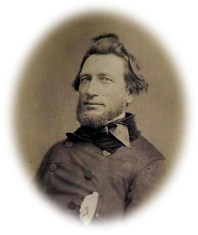1st–To day I rode over a mile from camp, to see–right in the woods, with but a little settlement surrounding it– the most aristocratic pile I have yet seen in Virginia. ‘Tis a large brick church, built in the form of a cross. As I approached it the first thing which attracted my attention, after I had wondered what it was doing there, was a black panel over the main entrance door, with this inscription :
“Built A. D., 1751; destroyed by fire, 1754,
and rebuilt
A. D., 1757, by Mourning Richards.
William Copen, Mason.”
I entered, and found two broad aisles crossing each other at right angles. The pulpit is built after the fashion of Trinity Church, New York, or somewhat in the style of that in the large Cathedral in Milwaukee, Wisconsin; but the the work is more elaborate than either of them, the minister having to pass into the third story of his pulpit before he has approached near enough to the Divine presence to catch his inspiration. The two lower stories are occupied severally by the Register and the Parish Clerk. The floor is of fine marble; the pews are square, with seats on all sides, and large enough to have seated, before the advent of crinoline, about twenty persons to each pew. At the end of one of the main aisles is a semi-circular enclosure, a resting place for the dead. On the beautiful marble floor which covers the mortal relics is deeply inscribed, and inlaid with gold:
“In
Memory
Of the race of the House
of
Monclure.”
Ah! and must the “memory of the race of the House of Monclure” be preserved only in gold? Could not he, the Vice-gerent of God–have written on hearts stony enough to retain the impression, the memory which he would have to live forever? Could he not have inscribed on tablets of memory, to pass as an heir-loom from generation to generation, an appreciation of that great precept which he professed–” Peace on Earth, and good will to man?”Then he might have gone, triumphantly exclaiming–
” Exegi monumentum perennius auro.”
But having entrusted the preservation of his memory more to gold than to Godliness, he is likely to be remembered in a manner which he little expected, for our soldiers have broken in, have torn up this marble floor, and are carrying away this golden momento “of the race of the house of Monclure,” as trophies of this unholy war. “The house,” at least, will be remembered. I have asked permission tonight, to occupy this church as a hospital, my chief object being to protect it from further vandalism.
In the wall, over this little enclosure which I have described, are four large black panels, the first and second containing part of the XXth Chap, of Exodus, the third, the Creed of the Church of England, and the fourth, the Lord’s Prayer, all in silvered letters–bright silvered letters on a black ground! How fitly emblematic of the spirit of the inscriptions to the darkness of the minds on which the living principles were to be impressed.
At the other end of this aisle is a high gallery, Another large black panel in this gallery bears the names of the (leadi)ng actors here, more than a hundred years ago. Let me help to imortalize those names :

May their names be recorded as plainly, and more durably, in a house not built with hands, as in the ephemeral pile now threatened with destruction.
